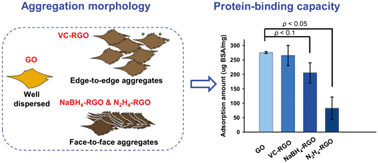Aggregation morphology is a key factor determining protein adsorption on graphene oxide and reduced graphene oxide nanomaterials†
Abstract
The analysis of the protein corona on (reduced) graphene oxides demonstrated that these nanomaterials preferentially adsorbed high-molecular-weight proteins through hydrophobic interaction. The counterintuitive observation that more reduced, and thus more hydrophobic, graphene oxides had lower adsorption capacities was attributable to the surface-functionality-determined, more significant aggregation of the reduced materials.

- This article is part of the themed collection: Environmental fate of nanomaterials


 Please wait while we load your content...
Please wait while we load your content...